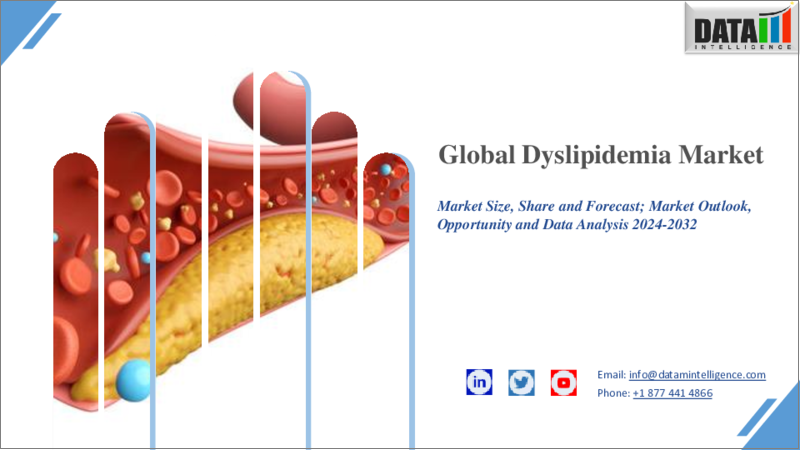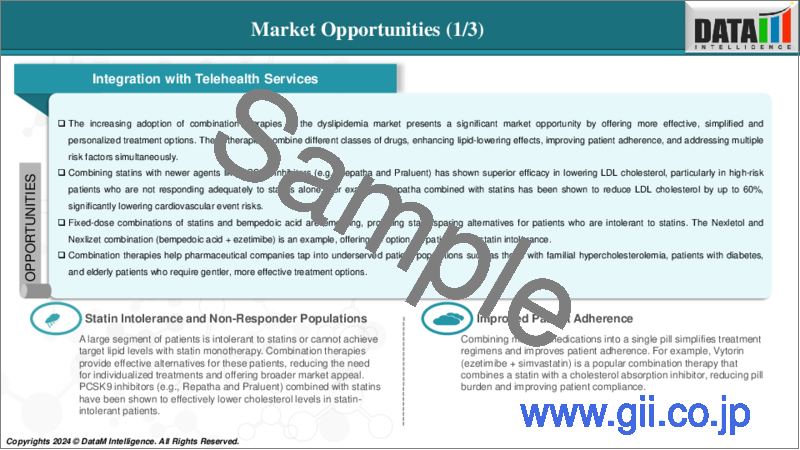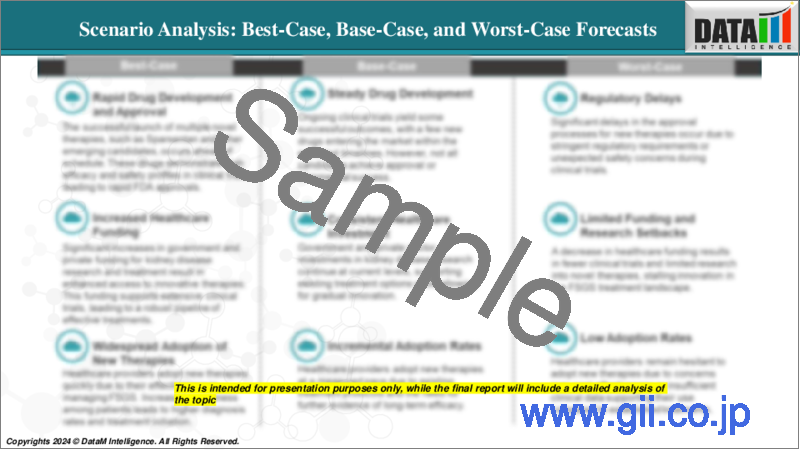|
|
市場調査レポート
商品コード
1594827
脂質異常症の世界市場 :2024年~2031年Global Dyslipidemia Market - 2024-2031 |
||||||
カスタマイズ可能
適宜更新あり
|
|||||||
| 脂質異常症の世界市場 :2024年~2031年 |
|
出版日: 2024年11月21日
発行: DataM Intelligence
ページ情報: 英文 195 Pages
納期: 即日から翌営業日
|
- 全表示
- 概要
- 目次
概要
脂質異常症の世界市場は、2023年に175億8,000万米ドルに達し、2031年には559億5,000万米ドルに達すると予測され、予測期間2024年にはCAGR 15.70%で成長する見込みです。
脂質異常症は、コレステロールやトリグリセリドを含む血液中の脂質(脂肪)の異常値を特徴とする病状です。脂質異常症は、低比重リポタンパク(LDL)コレステロール(「悪玉」コレステロール)の高値、高比重リポタンパク(HDL)コレステロール(「善玉」コレステロール)の低値、トリグリセリドの上昇など、脂質レベルに関連する様々な障害を包含する包括的な用語です。これらの脂質バランスの乱れは、冠動脈疾患、脳卒中、末梢動脈疾患などの心血管疾患のリスクを高める可能性があります。
脂質異常症市場の成長の原動力は、脂質異常症の有病率の高さと、世界の心血管疾患罹患率の上昇であり、特に高齢化した人口集団や、食生活の乱れや座りがちな行動といった生活習慣上の危険因子を抱える地域において顕著です。例えば、米国国立衛生研究所(NIH)は、世界保健機関(WHO)によると、世界の成人人口の39%が血中コレステロール上昇の影響を受けており、その有病率は男性(37%)よりも女性(40%)の方が相対的に高いと述べています。血中コレステロールの上昇は、この病気の負担を増加させるいくつかの結果をもたらす可能性があります。
市場力学:
促進要因と阻害要因
製品開発活動の活発化と規制当局の承認
脂質異常症市場は、製品開発活動の高まりとそれに続く商業利用のための規制当局の承認により、著しい成長を遂げています。脂質異常症疾患の負担が増加しているため、複数のメーカーが新規治療法の開発や既存治療法の改良に注力しています。
例えば、2024年6月、Daewoong Bio社は、高脂血症治療薬ロスバスタチンと栄養補助食品オメガ3を組み合わせた新製品を発売しました。この製品は、ロスバスタチン単独と比較して、脂質と不安定性の改善と忍容性を提供します。
規制当局の承認、特にFDAの承認の増加は、脂質管理のための革新的で効果的な治療オプション、特にスタチンなどの伝統的な治療法にあまり反応しない患者のための治療オプションを導入することにより、脂質異常症市場の成長を大きく促進しています。このような規制当局のサポートにより、脂質異常症治療用の新薬の利用が加速され、多様な患者のニーズに対応し、心血管系の転帰を改善することで、脂質異常症市場が拡大します。
例えば、2024年3月、米国食品医薬品局(FDA)は、Esperion Therapeutics, Inc.が開発したNEXLETOL(ベムペド酸)錠剤およびNEXLIZET(ベムペド酸およびエゼチミブ)錠剤を承認しました。これらの薬剤は、一次性高脂血症に対して単独またはスタチンとの併用で使用されます。
さらに2024年3月、米国食品医薬品局(FDA)は、リジェネロン・ファーマシューティカルズ・インクが開発したプラルエント(一般名:アリロクマブ)を、ヘテロ接合性家族性高コレステロール血症(HeFH)の8歳以上の小児患者に拡大適用することを承認しました。この薬剤は、食事療法や他の脂質低下薬との併用が可能です。
脂質異常症治療に伴う高額費用
先進的な脂質異常症治療、特にPCSK9阻害剤やRNAベースの薬剤のような新しい治療法の高コストは、脂質異常症市場成長の障壁となっています。例えば、NIHによれば、PCSK9阻害剤は当初年間約1万4,000米ドルの価格であり、高リスク患者のLDLコレステロールを低下させる効果があるにもかかわらず、利用しにくい薬でした。その後、一部の市場では年間約5,850ドルまで価格が引き下げられたもの、ジェネリック・スタチンと比較すると依然として高価です。
この価格格差は、特に保険未加入の患者や中低所得国の患者のアクセスを制限し、脂質異常症に対する患者のアドヒアランスを低下させる一因となっています。さらに、高コストはヘルスケアシステムと保険プロバイダーにプレッシャーを与え、しばしば償還政策を制限する結果となります。その結果、これらの先進的な薬剤の処方が減少し、脂質異常症に対する革新的な治療に対する需要が高まっているにもかかわらず、市場導入が遅れ、成長の妨げとなっています。
目次
第1章 調査手法と調査範囲
第2章 定義と概要
第3章 エグゼクティブサマリー
第4章 市場力学
- 影響要因
- 促進要因
- 脂質異常症の普及率の上昇
- 製品開発活動と規制承認の増加
- 抑制要因
- 脂質異常症治療に伴う高コスト
- 機会
- 影響分析
- 促進要因
第5章 産業分析
- ポーターのファイブフォース分析
- サプライチェーン分析
- 価格分析
- 特許分析
- 規制分析
- SWOT分析
- パイプライン分析
- 疫学分析
- アンメットニーズ
第6章 治療の種類別
- スタチン
- アトルバスタチン
- ロバスタチン
- ロスバスタチン
- その他
- 胆汁酸捕捉剤
- PCSK9阻害剤
- アリロクマブ
- エボロクマブ
- siRNA療法
- コレステロール吸収阻害剤
- フィブラート
- ナイアシン
- オメガ3脂肪酸誘導体
- その他
第7章 投与経路別
- 経口
- 非経口
第8章 流通チャネル別
- 病院薬局
- 小売薬局
- オンライン薬局
第9章 地域別
- 北米
- 米国
- カナダ
- メキシコ
- 欧州
- ドイツ
- 英国
- フランス
- スペイン
- イタリア
- その他欧州地域
- 南米
- ブラジル
- アルゼンチン
- その他南米
- アジア太平洋地域
- 中国
- インド
- 日本
- 韓国
- その他アジア太平洋地域
- 中東・アフリカ
第10章 競合情勢
- 競合シナリオ
- 市況・シェア分析
- M&A分析
第11章 企業プロファイル
- Viatris Inc.
- 会社概要
- 製品ポートフォリオと概要
- 財務概要
- 主な発展
- AstraZeneca.
- Organon group of companies.
- Regeneron Pharmaceuticals, Inc.
- Amgen Inc.
- Novartis AG
- Esperion Therapeutics, Inc.
- Pfizer Inc.
- Teva Pharmaceuticals USA, Inc.
- Lupin Pharmaceuticals, Inc.
第12章 付録
Overview
The global dyslipidemia market reached US$ 17.58 billion in 2023 and is expected to reach US$ 55.95 billion by 2031, growing at a CAGR of 15.70% during the forecast period 2024-2031.
Dyslipidemia is a medical condition characterized by abnormal levels of lipids (fats) in the blood, which include cholesterol and triglycerides. Dyslipidemia is an umbrella term that encompasses various disorders related to lipid levels, including high levels of low-density lipoprotein (LDL) cholesterol ("bad" cholesterol), low levels of high-density lipoprotein (HDL) cholesterol ("good" cholesterol) and elevated triglycerides. These lipid imbalances can increase the risk of cardiovascular diseases, such as coronary artery disease, stroke and peripheral artery disease.
The dyslipidemia market growth is driven by the high prevalence of lipid disorders and rising cardiovascular disease rates worldwide, especially in aging populations and regions with lifestyle risk factors like poor diet and sedentary behavior. For instance, the National Institute of Health (NIH), stated that according to the World Health Organization (WHO), 39% of the world's adult population has been affected by elevated blood cholesterol, with a relatively higher prevalence among women (40%) than among men (37%). Raised blood cholesterol can have several consequences that increase the burden of the disease.
Market Dynamics: Drivers & Restraints
Rising product development activities and regulatory approvals
The market for dyslipidemia is experiencing significant growth due to rising product development activities and subsequent regulatory approvals for commercial use. Due to the rising burden of dyslipidemia conditions, several manufacturers are focusing on developing novel therapies and advancing the existing ones.
For instance, in June 2024, Daewoong Bio launched a new product that combines the hyperlipidemia drug rosuvastatin with the dietary supplement Omega-3. It offers improvements in lipids and instability and tolerability compared to rosuvastatin alone.
Rising regulatory approvals especially FDA approvals are significantly driving growth in the dyslipidemia market by introducing innovative and effective treatment options for lipid management, particularly for patients who do not respond well to traditional therapies like statins. This regulatory support accelerates the availability of novel drugs for dyslipidemia treatment, expanding the dyslipidemia market by addressing diverse patient needs and improving cardiovascular outcomes.
For instance, in March 2024, the U.S. Food and Drug Administration (FDA) approved NEXLETOL (bempedoic acid) tablets and NEXLIZET (bempedoic acid and ezetimibe) tablets developed by Esperion Therapeutics, Inc. These drugs are used alone or in combination with statins for primary hyperlipidemia.
Additionally, in March 2024, the U.S. Food and Drug Administration (FDA) approved Praluent (alirocumab) developed by Regeneron Pharmaceuticals Inc. for extended application to pediatric patients aged 8 and older with heterozygous familial hypercholesterolemia (HeFH). This drug can be used in adjunct with diet and other lipid-lowering drugs.
High cost associated with the dyslipidemia treatment
The high cost of advanced dyslipidemia treatments, particularly newer therapies like PCSK9 inhibitors and RNA-based drugs, is a barrier to the dyslipidemia market growth. For instance, according to the NIH, PCSK9 inhibitors were initially priced at around $14,000 per year, making them less accessible despite their effectiveness in lowering LDL cholesterol in high-risk patients. Although prices have since been reduced to around $5,850 annually in some markets, they still remain costly compared to generic statins, which can be as low as $10 per month.
This price disparity limits access, especially among uninsured patients or those in low- and middle-income countries and contributes to lower patient adherence for dyslipidemia. Additionally, high costs put pressure on healthcare systems and insurance providers, often resulting in restrictive reimbursement policies. Consequently, fewer prescriptions for these advanced drugs are written, slowing market adoption and hampering growth despite rising demand for innovative treatments for dyslipidemia.
Segment Analysis
The global dyslipidemia market is segmented based on treatment type, route of administration, distribution channel and region.
Treatment Type:
The statins segment is expected to dominate the global dyslipidemia market share
Statins are the recommended first-line agents for the treatment of dyslipidemia. These drugs inhibit HMG-CoA reductase, an enzyme that plays a crucial role in the cholesterol biosynthesis pathway. By doing so, statins reduce the levels of cholesterol in the body and reduce the risk of cardiovascular events. Several regional health agencies and global health bodies recommend statins as a first-line treatment option for lowering LDL-C. For instance, according to the American Heart Association, statins are recommended for most dyslipidemia patients as they are more effective in risk reduction for heart attack and stroke.
Among the statins group for dyslipidemia, high-intensity statins such as Atorvastatin and Rosuvastatin are widely used. According to the 2023 European Society of Cardiology (ESC) guidelines, these drugs are indicated in patients with diabetes and at high risk for cardiovascular events, as they lower the LDL-c by 40% to 63%. Usage of these drugs also reduces the incidence of major cerebral and coronary complications.
Moreover, these drugs for dyslipidemia are among the top-selling lipid-lowering drugs worldwide. For instance, Atorvastatin sold under the brand name Lipitor, manufactured by Viatris Inc. has generated approximately US$ 1.5 billion in 2023. In addition, Rosuvastatin sold under the brand name Crestor, manufactured by AstraZeneca generated approximately US$ 1.1 billion in the same year.
The bile acid sequestrants segment is the fastest-growing segment in the dyslipidemia market
The bile acid sequestrants segment is expected to be the fastest-growing segment in the dyslipidemia market over the forecast period due to its role as an effective, non-systemic treatment option that lowers LDL cholesterol with fewer systemic side effects. Unlike statins, which are associated with muscle-related side effects, bile acid sequestrants work locally in the gastrointestinal tract to prevent bile acid reabsorption, thereby lowering cholesterol with minimal impact on the bloodstream. This makes them particularly valuable for statin-intolerant patients and those seeking combination therapies to manage their lipid levels.
Recent studies underscore the growing demand for bile acid sequestrants. For instance, the NIH study showed that combining bile acid sequestrants with statins can reduce LDL cholesterol by an additional 18%, a significant advantage for patients needing more aggressive lipid management. Additionally, as bile acid sequestrants are typically less expensive and have a long-standing safety profile, they appeal to both patients and healthcare providers looking for cost-effective alternatives. These factors, along with increased usage for both combination treatments, are driving the growth of bile acid sequestrants within the dyslipidemia treatment.
North America is expected to hold a significant position in the global dyslipidemia market
The North America region is expected to hold the largest share in the dyslipidemia market over the forecast period, owing to the higher prevalence of dyslipidemia, overall higher expenditure on healthcare and the strong presence of market leaders generating higher revenues in the region.
For instance, in March 2024, an epidemiology study published in the Journal of the American Heart Association stated that 25% of the adolescent population in the U.S. have dyslipidemia, and the prevalence cases are approximately 30% of the total population in the age group 18 to 39. The study suggested that early interventions and preventative measures among this population could prevent cardiovascular disease risks in the future.
Moreover, in the U.S., the risk of CVD is also higher. According to the American Heart Association, in the next 30 years 6 in 10 U.S. which is approximately 184 million people are expected to have one or the other type of CVD.
This alarming rise in dyslipidemia prevalence and the availability of advanced therapies contribute to the region's dominance in the global market. Several global leaders are operating actively in the region by investing in R&D activities, focusing on innovative product launches, etc. Moreover, these companies generate a major portion of revenue for their product from the North America region.
For instance, Novartis AG has launched LEQVIO (Inclisiran) a novel siRNA therapy for dyslipidemia, first in the U.S. market post its approval from the FDA. The product has bagged a sales value of US$ 355 million in 2023, and a major portion of it is generated from the U.S. market.
Asia Pacific is growing at the fastest pace in the dyslipidemia market
The Asia Pacific region is experiencing the fastest growth in the dyslipidemia market due to the rising prevalence of lipid disorders and increasing healthcare investments. Countries like China, India and Japan are witnessing significant lifestyle shifts, including increased consumption of high-fat diets and sedentary behaviors, contributing to an escalating burden of dyslipidemia and associated cardiovascular diseases.
For instance, according to the National Institute of Health, 2024, metabolic non-communicable disease health report of India: the ICMR-INDIAB nationwide cross-sectional epidemiological study (ICMR-INDIAB-17)12 on 113043 individuals (79506 from rural and 33537 from urban areas) showed the overall prevalence of dyslipidemia to be 81.2%. Low HDL cholesterol accounted for most with a prevalence of 66.9%.
Governments in the Asia-Pacific region are increasing healthcare spending, with an emphasis on preventive care and managing chronic diseases. For instance, Japan's "Healthy Life Expectancy" initiative includes aggressive screening programs for cardiovascular risk factors, fostering early detection and treatment of dyslipidemia. Moreover, multinational pharmaceutical companies are increasingly entering the Asia-Pacific market, forming partnerships with local firms to expand drug access and support new product launches.
Competitive Landscape
The major global players in the dyslipidemia market include Viatris Inc., AstraZeneca, Organon group of companies, Regeneron Pharmaceuticals, Inc., Amgen Inc., Novartis AG, Esperion Therapeutics, Inc., Pfizer Inc., Teva Pharmaceuticals USA, Inc., Lupin Pharmaceuticals, Inc. and among others.
Emerging Players
The emerging players in the dyslipidemia market include Arrowhead Pharmaceuticals, Inc., Alnylam Pharmaceuticals, Inc., Kowa Pharmaceuticals America, Inc., Gemphire Therapeutics Inc. and Ionis Pharmaceuticals, Inc. among others.
FDA Approvals
- In March 2024, Esperion cleared that the United States Food and Drug Administration (FDA) has approved broad new label expansions for NEXLETOL (bempedoic acid) Tablets and NEXLIZET (bempedoic acid and ezetimibe) Tablets based on positive CLEAR Outcomes data that include indications for cardiovascular risk reduction and expanded LDL-C lowering in both primary and secondary prevention patients. In addition, the enhanced labels support the use of NEXLETOL and NEXLIZET either alone or in combination with statins.
- In July 2023, the U.S. Food and Drug Administration (FDA) approved Leqvio (inclisiran) developed by Novartis AG, for extended application to earlier use in patients with elevated LDL-C who have an increased risk of heart disease, as an adjunct to diet and statin therapy.
Why Purchase the Report?
- To visualize the global dyslipidemia market segmentation based on treatment type, route of administration, distribution channel and region and understand key commercial assets and players.
- Identify commercial opportunities by analyzing trends and co-development.
- Excel data sheet with numerous data points of the dyslipidemia market with all segments.
- PDF report consists of a comprehensive analysis after exhaustive qualitative interviews and an in-depth study.
- Product mapping is available in excel consisting of key products of all the major players.
The global dyslipidemia market report would provide approximately 62 tables, 57 figures and 195 pages.
Target Audience 2023
- Manufacturers/ Buyers
- Industry Investors/Investment Bankers
- Research Professionals
- Emerging Companies
Table of Contents
1. Methodology and Scope
- 1.1. Research Methodology
- 1.2. Research Objective and Scope of the Report
2. Definition and Overview
3. Executive Summary
- 3.1. Snippet by Treatment Type
- 3.2. Snippet by Route of Administration
- 3.3. Snippet by Distribution Channel
- 3.4. Snippet by Region
4. Dynamics
- 4.1. Impacting Factors
- 4.1.1. Drivers
- 4.1.1.1. Rising Prevalence of Dyslipidemia
- 4.1.1.2. Rising Product Development Activities and Regulatory Approvals
- 4.1.2. Restraints
- 4.1.2.1. High Cost Associated with the Dyslipidemia Treatment
- 4.1.3. Opportunity
- 4.1.4. Impact Analysis
- 4.1.1. Drivers
5. Industry Analysis
- 5.1. Porter's Five Force Analysis
- 5.2. Supply Chain Analysis
- 5.3. Pricing Analysis
- 5.4. Patent Analysis
- 5.5. Regulatory Analysis
- 5.6. SWOT Analysis
- 5.7. Pipeline Analysis
- 5.8. Epidemiology Analysis
- 5.9. Unmet Needs
6. By Treatment Type
- 6.1. Introduction
- 6.1.1. Market Size Analysis and Y-o-Y Growth Analysis (%), By Treatment Type
- 6.1.2. Market Attractiveness Index, By Treatment Type
- 6.2. Statins*
- 6.2.1. Introduction
- 6.2.2. Market Size Analysis and Y-o-Y Growth Analysis (%)
- 6.2.3. Atorvastatin
- 6.2.4. Lovastatin
- 6.2.5. Rosuvastatin
- 6.2.6. Others
- 6.3. Bile Acid Sequestrants
- 6.4. PCSK9 Inhibitors
- 6.4.1. Alirocumab
- 6.4.2. Evolocumab
- 6.5. siRNA Therapy
- 6.6. Cholesterol Absorption Inhibitors
- 6.7. Fibrates
- 6.8. Niacins
- 6.9. Omega-3 Fatty Acid Derivatives
- 6.10. Others
7. By Route of Administration
- 7.1. Introduction
- 7.1.1. Market Size Analysis and Y-o-Y Growth Analysis (%), By Route of Administration
- 7.1.2. Market Attractiveness Index, By Route of Administration
- 7.2. Oral*
- 7.2.1. Introduction
- 7.2.2. Market Size Analysis and Y-o-Y Growth Analysis (%)
- 7.3. Parenteral
8. By Distribution Channel
- 8.1. Introduction
- 8.1.1. Market Size Analysis and Y-o-Y Growth Analysis (%), By Distribution Channel
- 8.1.2. Market Attractiveness Index, By Distribution Channel
- 8.2. Hospital Pharmacies*
- 8.2.1. Introduction
- 8.2.2. Market Size Analysis and Y-o-Y Growth Analysis (%)
- 8.3. Retail Pharmacies
- 8.4. Online Pharmacies
9. By Region
- 9.1. Introduction
- 9.1.1. Market Size Analysis and Y-o-Y Growth Analysis (%), By Region
- 9.1.2. Market Attractiveness Index, By Region
- 9.2. North America
- 9.2.1. Introduction
- 9.2.2. Key Region-Specific Dynamics
- 9.2.3. Market Size Analysis and Y-o-Y Growth Analysis (%), By Treatment Type
- 9.2.4. Market Size Analysis and Y-o-Y Growth Analysis (%), By Route of Administration
- 9.2.5. Market Size Analysis and Y-o-Y Growth Analysis (%), By Distribution Channel
- 9.2.6. Market Size Analysis and Y-o-Y Growth Analysis (%), By Country
- 9.2.6.1. U.S.
- 9.2.6.2. Canada
- 9.2.6.3. Mexico
- 9.3. Europe
- 9.3.1. Introduction
- 9.3.2. Key Region-Specific Dynamics
- 9.3.3. Market Size Analysis and Y-o-Y Growth Analysis (%), By Treatment Type
- 9.3.4. Market Size Analysis and Y-o-Y Growth Analysis (%), By Route of Administration
- 9.3.5. Market Size Analysis and Y-o-Y Growth Analysis (%), By Distribution Channel
- 9.3.6. Market Size Analysis and Y-o-Y Growth Analysis (%), By Country
- 9.3.6.1. Germany
- 9.3.6.2. U.K.
- 9.3.6.3. France
- 9.3.6.4. Spain
- 9.3.6.5. Italy
- 9.3.6.6. Rest of Europe
- 9.4. South America
- 9.4.1. Introduction
- 9.4.2. Key Region-Specific Dynamics
- 9.4.3. Market Size Analysis and Y-o-Y Growth Analysis (%), By Treatment Type
- 9.4.4. Market Size Analysis and Y-o-Y Growth Analysis (%), By Route of Administration
- 9.4.5. Market Size Analysis and Y-o-Y Growth Analysis (%), By Distribution Channel
- 9.4.6. Market Size Analysis and Y-o-Y Growth Analysis (%), By Country
- 9.4.6.1. Brazil
- 9.4.6.2. Argentina
- 9.4.6.3. Rest of South America
- 9.5. Asia-Pacific
- 9.5.1. Introduction
- 9.5.2. Key Region-Specific Dynamics
- 9.5.3. Market Size Analysis and Y-o-Y Growth Analysis (%), By Treatment Type
- 9.5.4. Market Size Analysis and Y-o-Y Growth Analysis (%), By Route of Administration
- 9.5.5. Market Size Analysis and Y-o-Y Growth Analysis (%), By Distribution Channel
- 9.5.6. Market Size Analysis and Y-o-Y Growth Analysis (%), By Country
- 9.5.6.1. China
- 9.5.6.2. India
- 9.5.6.3. Japan
- 9.5.6.4. South Korea
- 9.5.6.5. Rest of Asia-Pacific
- 9.6. Middle East and Africa
- 9.6.1. Introduction
- 9.6.2. Key Region-Specific Dynamics
- 9.6.3. Market Size Analysis and Y-o-Y Growth Analysis (%), By Treatment Type
- 9.6.4. Market Size Analysis and Y-o-Y Growth Analysis (%), By Route of Administration
- 9.6.5. Market Size Analysis and Y-o-Y Growth Analysis (%), By Distribution Channel
10. Competitive Landscape
- 10.1. Competitive Scenario
- 10.2. Market Positioning/Share Analysis
- 10.3. Mergers and Acquisitions Analysis
11. Company Profiles
- 11.1. Viatris Inc.*
- 11.1.1. Company Overview
- 11.1.2. Product Portfolio and Description
- 11.1.3. Financial Overview
- 11.1.4. Key Developments
- 11.2. AstraZeneca.
- 11.3. Organon group of companies.
- 11.4. Regeneron Pharmaceuticals, Inc.
- 11.5. Amgen Inc.
- 11.6. Novartis AG
- 11.7. Esperion Therapeutics, Inc.
- 11.8. Pfizer Inc.
- 11.9. Teva Pharmaceuticals USA, Inc.
- 11.10. Lupin Pharmaceuticals, Inc.
LIST NOT EXHAUSTIVE
12. Appendix
- 12.1. About Us and Services
- 12.2. Contact Us






